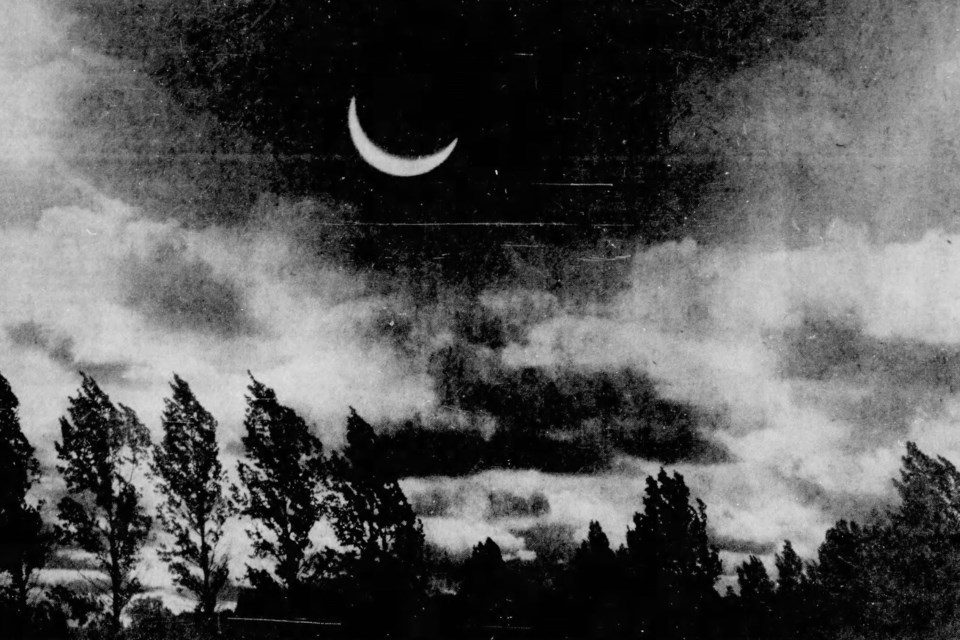From the archives of the Sault Ste. Marie Public Library:
While Sault Ste. Marie has seen its share of eclipses, the city has not experienced a total solar eclipse in recent history, according to a database of eclipses from 1900 to the present. Nevertheless, there were several dramatic partial eclipses visible from the city which made the news over the years.
In January 1925, any residents looking for a celestial show were out of luck as cloud cover blocked the view. The Sault Daily Star described the day as “rather a disappointment.” Nevertheless, the city was in for an eerie experience. The path of totality – the location that sees the sun fully blocked by the moon – was only about 50 miles to the south. As a result, almost all the sun was covered in Sault Ste. Marie, leading to a period of time in the morning so dark that streetlights had to be lit. The eclipse also allegedly affected radio, with the newspaper noting that “it [had] been difficult to get clear radio returns” and “there was a good deal more static” in the days leading up to the eclipse, particularly the night before.
In August 1932, residents had considerably more luck with the weather. While those in the path of totality, in and around parts of Quebec and New England, experienced cloudy weather and haze, Sault Ste. Marie was relatively clear. The eclipse also happened to fall within what the Sault Daily Star described as “the usual weekly holiday held by the merchants,” meaning there was an opportunity for thousands to take to the streets and watch the eclipse uninterrupted.
This time around, perhaps in part because of the timing in the afternoon, perhaps because it occurred at a warmer time of year, and perhaps because it was more visible overall, viewers noted more effects. As the headlines described, “Cows turn home as eclipse comes” and “Birds baffled by phenomenon,” although it is not clear from the article whether the affected animals were in Algoma or closer to the path of totality.
Locally, the temperature was notably affected. According to the Star, “People who sweltered during the morning in scanty clothing hurriedly donned heavier garments as evening approached.” This is a common phenomenon during solar eclipses: due to the obstruction of the sun’s light, the temperature will drop to levels typically seen after sunset. The average is about 5.5 degrees Celsius in the path of totality, but observers may experience a greater or lesser temperature drop.
The June 1954 eclipse was again a disappointment for those in the path of totality, with the news describing how astronomers “could only stand by helplessly” as the clouds obstructed their view. As far as Northern Ontario went, the eclipse was most visible in Sault Ste. Marie, with the moon covering up to 90% of the sun at its peak. Once again, the temperature dropped. It may not have been the most impressive solar experience, but it was certain enough to make the news.
As the years went on, concerns began to rise about the health risks of solar eclipses. By the time the July 1963 eclipse occurred, local businesses funded a full-page ad in the Sault Daily Star, proclaiming, “For your eyes’ sake… don’t look at the eclipse tomorrow!” and “Your children are in danger.” The prevailing advice was to bring children indoors for the duration of the eclipse. Safety-conscious adults viewed the eclipse through smoked glass (a tactic no longer considered safe), used a mirror to reflect the sun onto a wall, or just watched a television broadcast devoted to the celestial event. One teenager, an American visiting Sault Ste. Marie experienced permanent eye damage from viewing the eclipse unprotected; one resident of the Canadian Sault and two from the Michigan side also experienced less severe damage and irritation.
By the 1979 eclipse, newspaper ads were even more direct, reading, “You could be blinded…. There is no foolproof way of looking directly at the eclipse. No tinted or opaque glass protects the eye from damage. No glance, however, brief, is safe. No ‘trick’ view, like screwing up the eyes or looking through a pinhole, is safe. Children are most at risk. Supervise your children throughout the entire progress of the eclipse. Stop curiosity or bravado leading them into danger.”
School boards discussed how best to protect students’ eyes. They were particularly concerned due to the eclipse’s timing: it would be at its peak over lunch. In public schools, kindergarten classes were cancelled on the day of the eclipse. Some classes for older children that involved travel were also cancelled. Children were encouraged to bring their lunch and remain in school during the noon hour – in fact, students wishing to leave the school for their meal were requested to bring written permission from a parent.
Some people expressed frustration with the warnings and negative media attention, including one City employee who said, “I couldn’t sleep the night before the eclipse… I kept waking up in a cold sweat. I think they (media advertising) made it sound a lot worse than it was and they really got to the people.”
On April 8, 2024, Sault Ste. Marie will once again experience a partial solar eclipse, with an estimated 86 per cent of the sun blocked by the moon. Sault Ste. Marie is not expected to experience a total solar eclipse until May 3, 2106.
Each week, the Sault Ste. Marie Public Library and its Archives provide SooToday readers with a glimpse of the city’s past.
Find out more of what the Public Library has to offer at www.ssmpl.ca and look for more "Remember This?" columns here.
